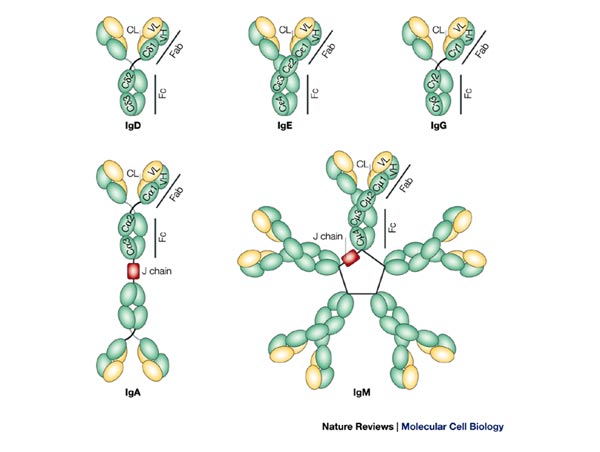I posited a question last post asking why two IgE antibody units had to cross-link one molecule of Allergen. No matter how hard I tried, I couldn't find an explanation as to why two IgEs have to be linked when bound to a mast cell's receptors in order for it to be activated. One hypothesis is that it makes the antigen-antibody complex big so it allows phagocytosis, or gobbling up by a large cell called a macrophage, to occur more easily.
To be more comprehensive, I'm going to expand upon immunoglobulins and mast cells.
An immunoglobulin (Ig), also called an antibody, is a Y-shaped molecule that binds to anything foreign in our bodies. In this way, the Ig marks what it binds to for other cells to look at and destroy. IgE is the least common of the 5 different kinds of immunoglobulins, unless you're allergy-prone, like me!
In this pic, you'll see how each type of Ig is structured differently, but made from an identically-shaped repeating structure. Keep in mind that a molecule's shape is extremely important in chemistry, and that the principle that each object binds to another object in a very specific way, holds true. So, if these Igs have different shapes, you can assume that they will bind to different structures in very specific ways. Likewise, if their shape is similar (as with the three in the top row), they may be able to bind to similar or the same type structure on another cell.
For an additional description of each type of Ig, where they are found, and what they do, see: http://www.webmd.com/a-to-z-guides/immunoglobulins
To be more comprehensive, I'm going to expand upon immunoglobulins and mast cells.
An immunoglobulin (Ig), also called an antibody, is a Y-shaped molecule that binds to anything foreign in our bodies. In this way, the Ig marks what it binds to for other cells to look at and destroy. IgE is the least common of the 5 different kinds of immunoglobulins, unless you're allergy-prone, like me!
In this pic, you'll see how each type of Ig is structured differently, but made from an identically-shaped repeating structure. Keep in mind that a molecule's shape is extremely important in chemistry, and that the principle that each object binds to another object in a very specific way, holds true. So, if these Igs have different shapes, you can assume that they will bind to different structures in very specific ways. Likewise, if their shape is similar (as with the three in the top row), they may be able to bind to similar or the same type structure on another cell.
For an additional description of each type of Ig, where they are found, and what they do, see: http://www.webmd.com/a-to-z-guides/immunoglobulins
© Nature Reviews/Molecular Cell Biology


 RSS Feed
RSS Feed
